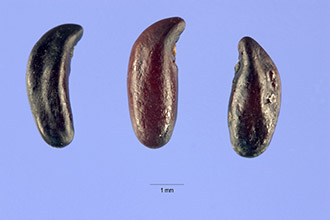Texas Kidneywood
Scientific Name: Eysenhardtia texana Scheele

| General Information | |
|---|---|
| Usda Symbol | EYTE |
| Group | Dicot |
| Life Cycle | Perennial |
| Growth Habits | ShrubTree, |
| Native Locations | EYTE |
Plant Guide
Use soil moisture sensors to measure the soil moisture of Texas Kidneywood.
Fact Sheet
Alternate Names
bee brush, vara dulce
Uses
The leaves of Texas kidneywood are highly palatable and nutritious. They are browsed by livestock, white-tailed deer, and mule deer. The plant is also of ornamental value because of its fragrant blooms, delicate foliage, and branching growth form. This is a good plant for use in deer food plots, and for native plant restoration projects. The nectar of the Texas kidneywood makes good honey, and dyes can be made from its wood.
Status
Please consult the PLANTS Web site and your State Department of Natural Resources for this plant’s current status (e.g. threatened or endangered species, state noxious status, and wetland indicator values).
Description
Texas kidneywood (Eysenhardtia texana) is a warm-season, native, perennial shrub that grows 6½-10 feet in height. It is a member of the legume family. Texas kidneywood has spiky white flowers that are sweet smelling. The vegetative parts of the kidneywood give off a citrusy odor when crushed.
Adaptation and Distribution
Distribution
Distribution
Texas kidneywood grows in Texas and south into Mexico. In Texas, it can be found in the Trans-Pecos, Edwards Plateau, Southern Coastal Prairie and Rio Grande Plains regions. It tends to prefer calcareous soils and is found as part of brushy, chaparral vegetation. Texas kidneywood prefers full sun or light shade. It is drought tolerant, but may temporarily defoliate under extended drought conditions. It grows rapidly under moister conditions. For a current distribution map, please consult the Plant Profile page for this species on the PLANTS Website.
Establishment
Texas kidneywood can be grown from seed or from cuttings, Seeds can be started outdoors in March, or started earlier indoors, Texas kidneywood appears to germinate best when temperatures fall between 68 and 86 ºF and when there are about 12 hours of daylight, Colder temperatures have been known to reduce germination, whereas higher temperatures tend to reduce the survival of new seedlings, However, Texas kidneywood has been known to germinate with no light and temperatures from 59-104 ºF, USDA NRCS Kika de la Garza Plant Materials Center Kingsville, Texas Kidneywood seeds can be planted hulled, or in the pod, Fresh untreated seeds can be planted, and we have had success in germinating hulled seeds that have been stored in a seed cooler for as long as 25 years (see our PMC's Technical Note # 6, 1999), Dr, Richard Hoverson recommended to PMC staff in a 1993 personal communication that if planting seedpods, they should be pre-soaked in distilled water for 72 hours prior to planting, with the water being changed every 8 hours, Seeds should be planted ¼-½ inch deep in a well-drained planting medium, A shallower planting depth of 1/8 inch is recommended for heavier, clay soil medium, We suggest that seedlings be started in plug trays or germination trays as they are susceptible to damping-off when young, At the PMC, we use a shallow tray with a thin layer of gravel, covered with a layer of sand, and topped with 1-1½ inches of planting medium, Seedlings can be moved to larger containers once they have three sets of true leaves, At this point, light fertilizer can be added to accelerate growth, Young plants may do better in light shade until they become established, Texas kidneywood can also be grown from soft or semi-hardwood cuttings, 4-6 inches long, taken in the summer and early fall, We recommend a rooting hormone be used to facilitate root growth, Cuttings tend to root in 3 to 4 weeks, We recommend that young plants be 6-9 inches in height when they are transplanted, Use soil moisture sensors to measure the soil moisture of Texas Kidneywood., The use of plastic plant shelters is beneficial to protect young plants from heavy browsing, reduce plant competition, and create a friendly microclimate until the young plant can get established, Fall transplanting gives young plants more time to establish before summer heat arrives,


